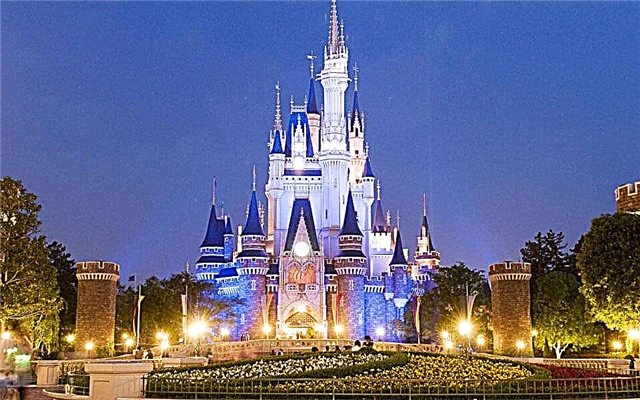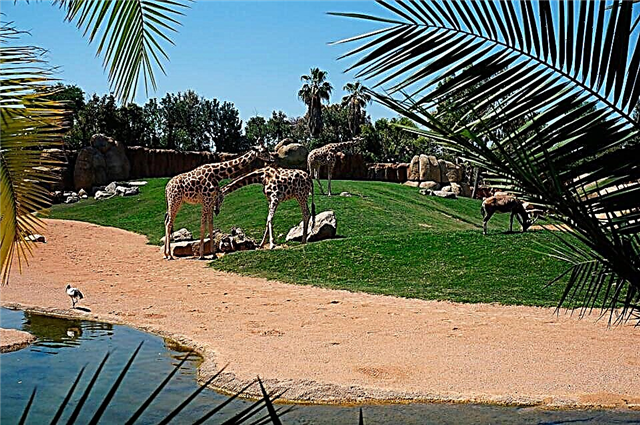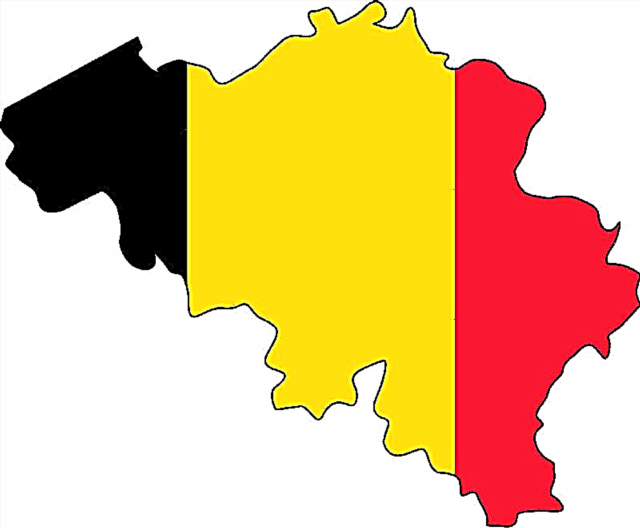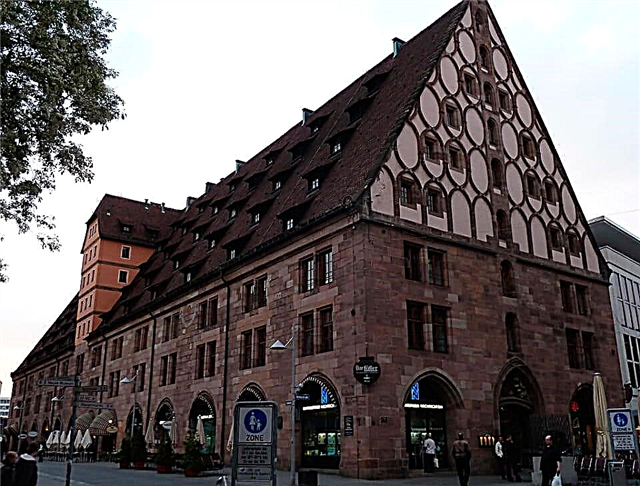The old German city is very popular with tourists visiting Germany. The attractions of Nuremberg are plentiful. Some of them - for example, the Market Square, fountains, many churches - can be viewed and photographed for free. You will have to pay for tickets to museums, but there are also various discounts: for children, students, organized groups, etc.
Nuremberg fortress

The symbol of the city is the Imperial Castle (Nuremberg Fortress), built in the Middle Ages, at the beginning of the 11th century. Of course, since then it has been destroyed more than once in the course of wars, then rebuilt again. The main advantage has always been its location - it is here that important trade routes converge. Therefore, the emperors made the Kaiserburg their residence, and it was so until the middle of the 17th century. The castle was reconstructed several times in the 19th century and then in the 20th - as it was badly damaged at the end of World War II. Today, guests visit the palace where the emperors lived - their private chambers, and the halls for official ceremonies.
Many ancient architectural details have been preserved. Of particular interest is the Double Chapel, which was built in the 13th century. The Round Tower belongs to the same period. A century later, a well appeared here, which has since uninterruptedly supplied the inhabitants of the castle with clean water. In the warm season, from April to September, you can see the castle from 9 to 18 hours, from March to October - from 10 to 16 hours.
Market Square

Not everyone knows that on the site of the square, where large-scale seasonal fairs are regularly held today, there used to be a Jewish ghetto. The Nazis burned about six hundred people who lived here. Since then, this place has not been built up with new houses. A fountain can be seen here today. Nearby is the "Ring of Desires". It is attached to the lattice, and in order for wishes to come true, you just need to come up and hold it in your hands. According to popular belief, one should only think of something good.
Another attraction of the Market Square is the Church of the Virgin Mary. Many visitors to the city come here at noon to look at the wonderful clock with figures, which shows a whole performance at 12 o'clock. This spectacle is especially pleasing to children. From the Market Square you can easily reach other attractions of the city.
Church of Our Lady (Frauenkirche)

This wondrously beautiful church was built in the second half of the 14th century, according to the original plan, imperial ceremonies were to be held here. It has not been established exactly, but most historians are of the opinion that the architect was Peter Parler, known all over the world, thanks to the Prague Cathedral of St. Vitus. Inside the church, you can see relics from the Middle Ages, listen to the organ, and at noon admire the movement of the figures installed in the astronomical clock. The church can be visited freely, entrance tickets are not required.
Church of St. Lawrence

Another old church, which the city is rightfully proud of. It began to be built at the end of the 13th century and took almost two centuries to build. The striking Gothic building is made of dark red sandstone. A bit gloomy, but it looks beautiful, and the photos are spectacular. Even without going inside, you can look at the outside of the temple for a long time, in particular - its bas-reliefs, which depict scenes from the Bible - the Birth of Christ, His life, the massacre of babies during the time of King Herod.

In the church itself, tourists are greatly impressed by the sculptural group "Annunciation", made of wood by Veit Stoss, and a huge stone tabernacle, created by Adam Kraft. Its size reaches 18 m. The base is supported by 3 male figures, executed in an extremely naturalistic way, and biblical scenes can also be seen on the panels and bas-reliefs. It seems like a miracle that this tabernacle of the finest work was preserved during the bombing of the Second World War, when the city was practically turned into ruins. The glory of the church was brought by its beautiful stained-glass windows.
Albrecht Durer House Museum

The Germans remember and honor the great artist. He bought this house in 1509, when the building was already almost a century old. Dürer moved here with his wife and servants, as well as with his students, and lived here until his death - that is, for about 20 years. After that, the owners of the house replaced each other. In the 19th century, the city authorities bought the building and designed a small museum here, and then the matter passed to the "Society of the House of Albrecht Durer". The collection of exhibits is still being replenished. Fans of the artist's creativity were very pleased with the fact that during the war the building was almost not damaged, and in 1949 the museum already received visitors again.
Today, audio tours are held here, and the story is very interesting - it is conducted on behalf of the artist's wife. You can also watch a film dedicated to the life and work of Dürer, visit the rooms where the family lived, and see the "art gallery". The doors of the museum are open from 10 am to 5 pm. In the gift shop, everyone who has bought a ticket and made any purchase is also entitled to a gift.
German national museum

This world-renowned museum was born in the first third of the 19th century, thanks to the efforts of Baron Hans von Aufsess. He began collecting works of German painters and sculptors, interesting antiques. In the 50s, the museum was opened. The number of exhibits grew, and over time the museum moved to the premises of an old monastery, which gave it an additional flavor. By that time, the collections already included works by Faith Stoss, Adam Kraft and other masters. After World War II, the museum was revived thanks to Theodore Heuss. He became its director, and put a lot of effort into replenishing the collections. Today there are 23 departments here.
Visitors can see archaeological finds dating back thousands of years, paintings by masters from different eras and works of contemporary painters. It also houses ancient instruments used by scientists of the past centuries, and things created by folk craftsmen. Children admire antique toys, including doll houses. Also in the museum you can listen to the playing of musical instruments made many centuries ago. The museum is closed on Monday. On other days, it receives visitors from 10 to 18 hours, and on Wednesdays from 10 to 21 hours.
Fountain "Marriage Carousel"

This fountain is located on Ludwigplatz square. It owes its appearance to the following reason. A subway was being built in Nuremberg, and it was in this place that a ventilation shaft had to be made. How to disguise it? The city authorities announced a competition for the best idea. The winner was Jurgen Werber, a sculptor by profession, who proposed to create a composition based on the works of the famous German poet Hans Sachs, who lived in this city in the Middle Ages.
Sachs has poems dedicated to married life, its bitter and sweet fruits. The fountain consists of 6 sculptural compositions arranged in a circle. They personify both the joyful and sad moments of the relationship between husbands and wives. There are always many tourists here who are in a hurry to capture the fountain - a real work of art - in photographs.
Church of St. Sebald

This is the oldest church in Nuremberg, built in the Gothic style. The work began in 1225 and lasted for about 150 years. It is especially dear to the residents that the temple was erected in honor of the patron saint of the city. Sebald was a hermit and lived in a forest near Nuremberg. He was canonized in the 15th century, and now his relics are kept in this temple.In previous years, on St. Sebald's Day, which is celebrated on August 19, they were solemnly carried through the streets of the city.
Once upon a time there was a small chapel on the site of the church. Then it was replaced by a basilica in the Romanesque style, then the restructuring continued, Gothic elements appeared, and then the features inherent in the Baroque. Today the main attractions of the church are the old altar, dating from the 15th century, and the bas-reliefs of Adam Kraft. You can also see beautiful wooden sculptures here.
Palace of Justice

The significance of this palace for the whole world can be described in a few words - it was here that the Nuremberg trials took place in 1945-1946. The fascists who have committed grave crimes against humanity were in the dock. The building was built at the beginning of the 20th century. Later, members of the Nazi party held their conventions here. Surprisingly, during the terrible bombing during the Second World War, the palace survived. There was a prison nearby. All this played an important role when the Allies chose the site for the trial of the Nazis.
About 20 years after that, the building belonged to America, then it was transferred to Germany. At the same time, reconstruction was carried out - with the replacement of cladding and furniture. Now court hearings are taking place here. And, of course, the Museum of the History of the Nuremberg Trials is open here. On weekends, visitors have the opportunity to inspect the very hall where the hearings were held, to get acquainted with documents and photographs. Even to see the benches on which the defendants were sitting. On other days of the week, when court hearings are held here, you can look into the hall through special glass windows.
On Saturdays and Sundays, the museum is open from 13:00 to 17:00, a ticket costs 8 euros, children are free, and students are for half the price.
House of Nassau

There is no older residential building in Nuremberg than the House of Nassau. It is located at the corner of Lorenplatz and is a real tower. Such structures were typical of medieval Italy. The house was built from red sandstone. It has 4 floors. Reconstructions gradually changed his style from Romanesque to Gothic. Construction was carried out gradually: it began in the 12th century, and the upper floors were completed already in the 15th. Particularly interesting is the roof of the house, where you can see numerous coats of arms - cities, Greek cities and even the Pope.
The building in turn belonged to one or another aristocratic family, and today it is owned by a special fund. Tourists have the opportunity to see how representatives of the upper strata of society lived in the Middle Ages. Unlike the wooden houses of commoners, the massive building survived even during the bombing of the city during World War II. It was restored already in the 50s of the last century. Now the house is used by the city administration.
Mauthalle building

The Mauthalle building is attractive for city guests. First of all, tourists will be interested in its unusual architecture, numerous windows located on the roof. The fact is that grain was once stored here. To prevent it from becoming moldy, the room had to be regularly ventilated. Small windows served this very purpose. Then the customs office was opened in the building, and then the shopping center was moved here.
Thus, tourists can inspect the inside of the house and make purchases. And in the basement, another surprise awaits them. There is a wonderful pub where you can sit and relax over a large mug of amber foamy drink. Among other appetizers, guests are offered the famous Nuremberg sausages, which have won universal recognition for a long time.
Tucher Castle (Tuchershloss)

Once upon a time, in the 16th century, wealthy Tuhera merchants lived in a beautiful castle surrounded by a garden. Thanks to their marriage ties, they became related with many noble families of Nuremberg. For four centuries, the massive building stood in its original form, but the Second World War did not spare it, and the bombing caused significant damage to the structure. In fact, only the western facade remained from the castle, everything else had to be restored.

Today, tourists can visit the museum located here, admire antique furniture, household items, clothes, paintings, sculptures. All this is provided by the Tucher family. Luxurious wedding tableware is of particular interest to tourists. A historic building from the Renaissance era has been recreated in the garden.
The museum is open on Mondays from 10 to 15, on Tuesdays from 13 to 17 and on Sundays from 10 to 17 hours. It should be especially noted that on Sundays the excursion is conducted by an artist dressed in the clothes of the mistress of the castle Frau Tucher, and she narrates the story on her behalf. You can spend the whole day here, as there is a beautiful park around the castle.
Hospital of the Holy Spirit

One of the oldest buildings in Nuremberg is actually the oldest medical institution in Europe. Even at the beginning of the 14th century, the sick were treated here, there was also an almshouse, where beggars could be taken to live, and even those with leprosy - in isolated rooms, of course. The hospital has been of great importance for several centuries. The Germans are true to tradition. Today, the Hospital of the Holy Spirit houses the Nursing Home. But tourists are also very fond of visiting this place.
There is a wonderful restaurant serving the best national cuisine. Everything is tasty, fresh, home-cooked. In addition, the building looks extremely picturesque. One of its wings precisely hangs over the water, and arches are reflected in its smooth surface, resembling glasses. The hospital's wooden gallery, which has been preserved since the Middle Ages, is also a rare architectural monument. Also, this building once housed the "Spear of Destiny", which personified the power of Rome.
"Beautiful" fountain

There is a legend that the fountain, whose height reaches 19 m, was originally planned to be the spire of the Frauenkirche church, but the composition turned out to be too heavy to lift it up. One way or another, master Fritz Pfinzing began to build the fountain at the end of the 14th century, and 11 years later the work was completed by Heinrich Beheim, since Fritz was no longer in the world. The sketch for the grandiose structure belonged to the very Kaiser Charles the Fourth.
It was important for the inhabitants of the medieval city to have a water source located in the main square. And the sculptural composition reflects the system of values of that time. Over 40 figures, including apostles, kings, scientists, prophets, are located on different tiers. The topmost level represents Justice. Here are Moses and the prophets, and in the lower part of the fountain you can see devils - protected from evil forces, which is consistent with the ancient tradition.
Nuremberg zoo

This is the real pride of Nuremberg, and a paradise for animals. They live here in conditions that are as close to natural as possible. But at the same time they are safe and provided with food. The animals are gullible and sociable. And monkeys can even ransack backpacks and pockets of careless tourists. Elephants, rhinos, giraffes, kangaroos - representatives of the fauna of all continents live here. And the Floke bear is a favorite of both guests and staff of the zoo, a kind of its emblem. Also, children and adults will be delighted by a visit to the dolphinarium, where smart sea animals give whole performances.
There is a cafe and a bar on the territory. The zoo is open every day from 8 to 19.30, the ticket price for an adult is 13.5 euros, for children 6.5 euros. Feeding of animals is carried out according to the schedule. It will take more than one day to carefully and thoughtfully examine all the sights of ancient Nuremberg. But the city is worthy of your time. You can come here during the "low season", when there are not so many people here, and housing prices are lower. Nuremberg remains beautiful at any time of the year.











